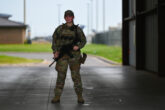November 01, 2017
Washington Is Never Quite Sure Where It Is at War
The United States is a nation at war. But for much of the past two decades, a great deal of the Pentagon’s overseas activities would not technically classify as combat, with all its attendant logistical trappings and legal tango. In fact, much of this activity receives rather benign categories: “building partner capacity”; “Light footprint” ; or “Assisting or accompanying,” like a maiden aunt chaperoning a young couple to a dance. But from the ground, some of this stuff still looks an awful lot like combat. If America romanticizes warfare, it idealizes much of what the Pentagon calls “military operations other than war.”
In response to the deaths of four U.S. soldiers in Niger in early October, Senators Lindsey Graham and Bob Casey, standing in for many of us, expressed surprisethat the U.S. military was even present in the country. I’ll give them the benefit of the doubt: What they really meant was that they were not aware they needed to worry about the presence of U.S. troops in Niger. Spoiler alert: they did. The post 9/11 wars have launched a multitude of well-intentioned, but deceptively risky activities intended to increase global security on the cheap. In the process, political oversight, and potential for success, may have been shortchanged too.
While there’s nothing particularly new about the fact that America is helping build the capacity of more than 100 foreign militaries, this approach has grown more popular—and for good reason: It’s seen as a sweet deal. The United States has spent billions (versus potential trillions) on this “indirect approach,” working by, with, and through, foreign partners in innovative, low-cost, and small-footprint efforts to achieve its security objectives. It has trained, advised, assisted, sometimes accompanied, and enabled. While it has generated a cornucopia of terminology, it has failed to confront the fact that, in truth, many of these activities constitute a low-key means of achieving the outcomes of a major military intervention without the requisite investment of blood, treasure, and political capital that comes with formal declarations of war—or attention to risk.
Read the full op-ed in The Atlantic.
More from CNAS
-
National Security Human Capital Program
Short SupplyExecutive Summary The U.S. military faces a critical challenge: Fewer young Americans are willing to serve, and fewer adults are encouraging them to do so. Because of delibera...
By Katherine L. Kuzminski & Taren Sylvester
-
National Security Human Capital Program
Defending the Army’s Command Assessment ProgramThe concept for CAP — developed during the first Trump administration — benefited from the guidance, input and oversight from the foremost scholar and practitioner on military...
By Katherine L. Kuzminski
-
National Security Human Capital Program
‘Women Don’t Just Achieve…They Excel’: Fmr. Marine Corps Attack PilotDr. Kyleanne Hunter, former Marine Corps attack pilot and CEO of Iraq & Afghanistan Veterans of America, says “women are the fastest growing group of veterans” and “the fastes...
By Dr. Kyleanne Hunter
-
National Security Human Capital Program
A Workforce Strategy for America’s Shipbuilding FutureThe future of American maritime dominance will not be determined solely by the number of ships launched or contracts signed, but rather by the strength and sustainability of t...
By Katherine L. Kuzminski & Laura Schmiegel




